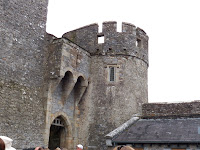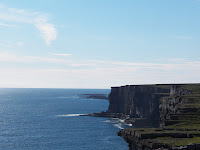The first stop was The Rock of Cashel. This impressive structure has its origins in the 1000s as the seat of the king of Munster (South Ireland today). He was a powerful king, and was converted to Christianity by St. Patrick. Legend has it that as Patrick was performing the baptismal ceremony, he set his staff down so hard, it pierced the king's foot, but he didn't say a word. When Patrick realized what happened, he asked the king why he didn't complain. He thought it was part of the process!
Later in about the 1200s, ancestors of the king donated the castle to the Church where it was converted to also contain a magnificent cathedral. It was the seat of the bishop of Munster until the 1700s. The place is also called St. Patrick's rock for its association to the man who brought Christianity to Ireland.
Just down the hill from Cashel is Hore Abbey. Yes, just like it sounds. While today it makes the place sound like a brothel, "hore" is actually the word for gray. The abbey was named for the gray cloaks worn by the monks.
The abbey was actually burned to the ground because one king had a dream that the monks tried to murder him... senseless? Well, the monks found a new home and never killed him...
The next stop was Cahir Castle, historically owned by the Butler family, named for their position as chief butlers to the English monarchy. We took a tour focusing on all the ways we, had we been attacking soldiers, could have been killed. This place was invincible before the days of explosives! Full of slits for archers and gaps for pouring hot lime and boiling fat on intruders, I think the most "inventive" defense was to sling dead bloated animals onto the attacking forces. The gasses in the animal made its rotting guts explode all over the now very demoralized and probably infected soldiers.
The castle does, however, bear a mark of more modern warfare... a cannon ball has been lodged in the wall for the past 400 years. At the bottom of the castle is the oubliette, or dungeon. Named for the French word "oublier," "to forget," this is where they locked away prisoners. It was dark and damp and very dungeon-y. On another note, this castle was used in the filming of Braveheart! When Mel Gibson first arrived, they didn't recognize him and made him pay for a tour.
The final stop was Ormond Castle and Manor House. Also owned by the Butler family in Elizabethan (late 1500s) times, this place was a mash-up of a Norman (1100s) and Elizabethan structure. The Norman structure was in ruins, but was impressive nonetheless. We toured inside of the restored manor house, but no pictures were allowed. It was partially furnished with pieces from the time, and we were able to see the original plasterwork and walk the maze of rooms from ground floor to attic.
America doesn't have castles and structures 1000 years old, so compared with the newness and future-forward America, it was surreal to walk along these places which have amazed people for a millennium and think of an entirely foreign people, separated from us by the walls of time, leaving us only ruins of their ingenuity.





























































































